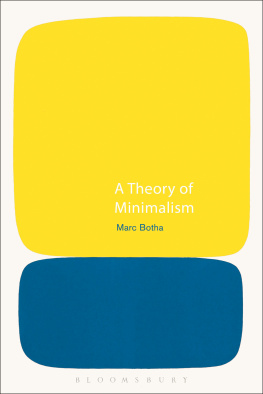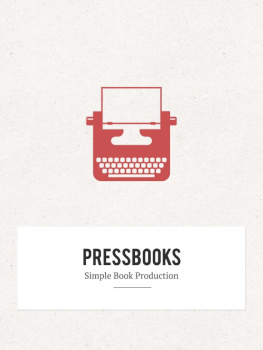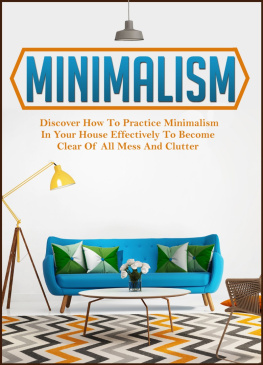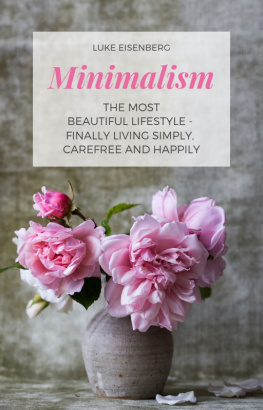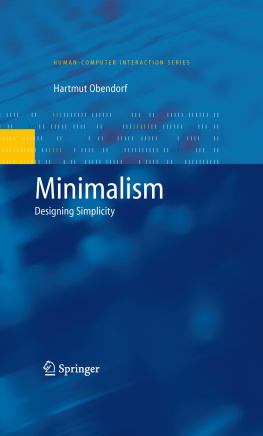Marc Botha - A Theory of Minimalism
Here you can read online Marc Botha - A Theory of Minimalism full text of the book (entire story) in english for free. Download pdf and epub, get meaning, cover and reviews about this ebook. year: 2017, publisher: Bloomsbury, genre: Science. Description of the work, (preface) as well as reviews are available. Best literature library LitArk.com created for fans of good reading and offers a wide selection of genres:
Romance novel
Science fiction
Adventure
Detective
Science
History
Home and family
Prose
Art
Politics
Computer
Non-fiction
Religion
Business
Children
Humor
Choose a favorite category and find really read worthwhile books. Enjoy immersion in the world of imagination, feel the emotions of the characters or learn something new for yourself, make an fascinating discovery.
- Book:A Theory of Minimalism
- Author:
- Publisher:Bloomsbury
- Genre:
- Year:2017
- Rating:5 / 5
- Favourites:Add to favourites
- Your mark:
- 100
- 1
- 2
- 3
- 4
- 5
A Theory of Minimalism: summary, description and annotation
We offer to read an annotation, description, summary or preface (depends on what the author of the book "A Theory of Minimalism" wrote himself). If you haven't found the necessary information about the book — write in the comments, we will try to find it.
A Theory of Minimalism — read online for free the complete book (whole text) full work
Below is the text of the book, divided by pages. System saving the place of the last page read, allows you to conveniently read the book "A Theory of Minimalism" online for free, without having to search again every time where you left off. Put a bookmark, and you can go to the page where you finished reading at any time.
Font size:
Interval:
Bookmark:

A Theory of Minimalism
Also available from Bloomsbury
Reparative Aesthetics , Susan Best
Aesthetics and Architecture , Edward Winters
Aesthetics and Painting , Jason Gaiger
Expanded Painting , Mark Titmarsh
Aesthetics of Ugliness: A Critical Edition , Karl Rosenkranz
For my parents, Neville and Annette
A Theory of Minimalism
Marc Botha
Bloomsbury Academic
An imprint of Bloomsbury Publishing Plc

Contents
I have benefited immensely from exchanges at various points of this research with, among others, Derek Attridge, Stephen Bann, Carrol Clarkson, Timothy Clark, Frances Colpitt, Alec Finlay, Daniel Grausam, Francisco-J Hernndez Adrin, Ulrike Kistner, Liliane Lijn, Ulrika Maude, Nico Muhly, John Nash, Reingard Nethersole, Jelena Novak, Christopher Norris, Marc Schachter, Stuart Sim, Henry Staten, Jennifer Terry, Samuel Thomas, David Watson, Patricia Waugh, Andries Wessels, Russell West-Pavlov, Merle Williams and Heather Yeung. I am especially grateful to Pat, Maebh and Heather for their intellectual generosity and friendship. Also, to my former colleagues at the University of Pretoria, current colleagues at the University of Durham, and to numerous other interlocutors and friends from various conferences, symposia, lectures, reading-groups and publications with whom I have had the privilege of corresponding, formally and informally, my sincere thanks.
My thanks to Liza Thompson and Frankie Mace at Bloomsbury for their patience and assistance, to Simon Cutts from Coracle Press, and to Tate and M HKA Antwerp for permission to reproduce verse and image. Much of this research was funded by a Durham Doctoral Fellowship at Durham University and, subsequently, by a Postdoctoral Research Associateship on the Leverhulme Trust Tipping Points project. My thanks to both organizations for their support.
There are many friends outside of academia who have been tremendously supportive: you know who you are and just how much your friendship means to me. But my first and final and greatest debt of gratitude is to my family: to my parents, Neville and Annette, to whom this book is dedicated; to my sister Andrea and her family, Jake, Helen and Olivia; to my aunts Yvonne and Lorraine; to my godfather Walter and to Annelize.
As the title suggests, this work offers a theory of aesthetic minimalism. It is a general theory inasmuch as it addresses minimalist works as they manifest across a range of expressive media in the visual arts, music, literature, architecture and performance. It does not seek to fix a definitive canon of minimalist works, nor to prescribe a formula for approaching minimalism. Rather, it offers a theory in the sense of the Greek term theoria : a way of seeing or viewing. Since its object minimalism is comprised of works that vary considerably in conception, medium, execution and commitment, a theory of minimalism worthy of its name must necessarily be dynamic and capable of drawing out connections between often disparate works. In short, a theory of minimalism must offer not a single view of minimalism, but multiple views.
Studies of minimalism have tended to fall into two broad categories: historical accounts that focus on minimalism as a chronologically delimited movement, usually drawing attention to a central canon of works and occasionally its precursors and successors; and formalist accounts that concentrate on the properties or qualities of minimalist works and how these differ from or conform to other aesthetic categories. In some studies these two paradigms intersect, while in others they are kept largely apart. In other studies, greater attention is given to the economic, social and political complexities that frame the emergence of minimalist aesthetic works. Without sacrificing the many gains from these different approaches, the present work aims to broaden and deepen the study of minimalism by developing a conceptual vocabulary that is able to reground minimalism, and in so doing also to clarify connections between these often competing accounts.
My principal claim is that minimalism cannot be reduced to a set of works or stylistic markers no matter how inclusive or exhaustive. Instead, I suggest that minimalism is best grasped as an existential modality : a way of existing in the world. What connects different types of minimalism aesthetic, linguistic, legal, computational, or lifestyle is that their existence is entangled with and comported towards minimum . Minimum finds two principle expressions: the infinitesimal, or the least possible ; and the parsimonious, or the least necessary . In this light, it becomes possible to define aesthetic minimalism, in appropriately minimalist terms, as the investigation of the least possible and the least necessary across a range of media and works. Yet, as soon as minimalism is grasped in such broadly existential terms, it becomes evident that it is a transhistorical phenomenon that seems to emerge in some form or another in every historical epoch.
Thus, drawing on a range of examples, I argue that minimalism is far more diverse than is often admitted. In this light, my wager is that a general theory, as distinct from a complete theory, requires an eclectic conceptual approach, since it must be equally responsive to often very different types of minimalism with distinct historical trajectories. The radical concerns that pervade minimalism span numerous conceptual paradigms, often placing these different paradigms in conversation. Although I examine the variety of these conversations, the overall commitment of my argument is to a type of realism. In particular, I am concerned with a minimalist species of realism that aims to delineate that which is most radical to every real situation without proposing any sort of dogmatic theory of reality. It is these minimal conditions of the real that I believe aesthetic minimalism exemplifies with particular force. In simple terms, what I try to offer is a realist theory of minimalism that is able to feed into a minimalist theory of realism. In essence, I am concerned with the type of realism that the phenomenologist, Roman Ingarden, conceives in terms of the convergence, rather than the incommensurability, of reality as it is arrived at through perception, and reality as it exists independently of perception. I argue that minimalism, understood broadly as an aesthetic modality, intensifies and clarifies access to the real.
This theory is advanced by developing seven distinct concepts historical intermittency, the encounter, objecthood, the real, radical quantity, lessness and minimum which together frame a dynamic approach to minimalist aesthetics as a transhistorical existential modality. Each chapter is further divided into sub-sections which together constitute a constellation of concepts, each tied to a specific example, or series of examples, of minimalist works often canonical, but including more peripheral and unacknowledged expressions of minimalism.
The opening chapter, Intermittency: On the Transhistoricism of Minimalism, introduces the concepts of minimum and minimalism, making a case for the latter as an existential modality as outlined above, rather than simply as a chronologically delimited movement or a closed set of attributes. What I develop instead is a transhistorical theory of minimalist aesthetics. Minimalism, as with many other radical aesthetic modalities, is governed by the correlative logics of return and intermittency , adapted from Hal Foster and Andrew Gibson respectively. The radical force of minimalist aesthetics lies not in a single, historical event, but rather in its capacity to return, and in returning to turn aesthetics towards its most radical possibilities. Minimalism constitutes an event which in the singularity of its eruption conserves the potential for its intermittent return. Far from diluting the historical singularity of the minimalist moment of the mid-twentieth century, poised as it was between the modern and the postmodern, this dynamic conception intensifies our understanding of what it in fact means for minimalism to occupy a threshold position, and the immense potentiality invested in many of its works as a result.
Font size:
Interval:
Bookmark:
Similar books «A Theory of Minimalism»
Look at similar books to A Theory of Minimalism. We have selected literature similar in name and meaning in the hope of providing readers with more options to find new, interesting, not yet read works.
Discussion, reviews of the book A Theory of Minimalism and just readers' own opinions. Leave your comments, write what you think about the work, its meaning or the main characters. Specify what exactly you liked and what you didn't like, and why you think so.

